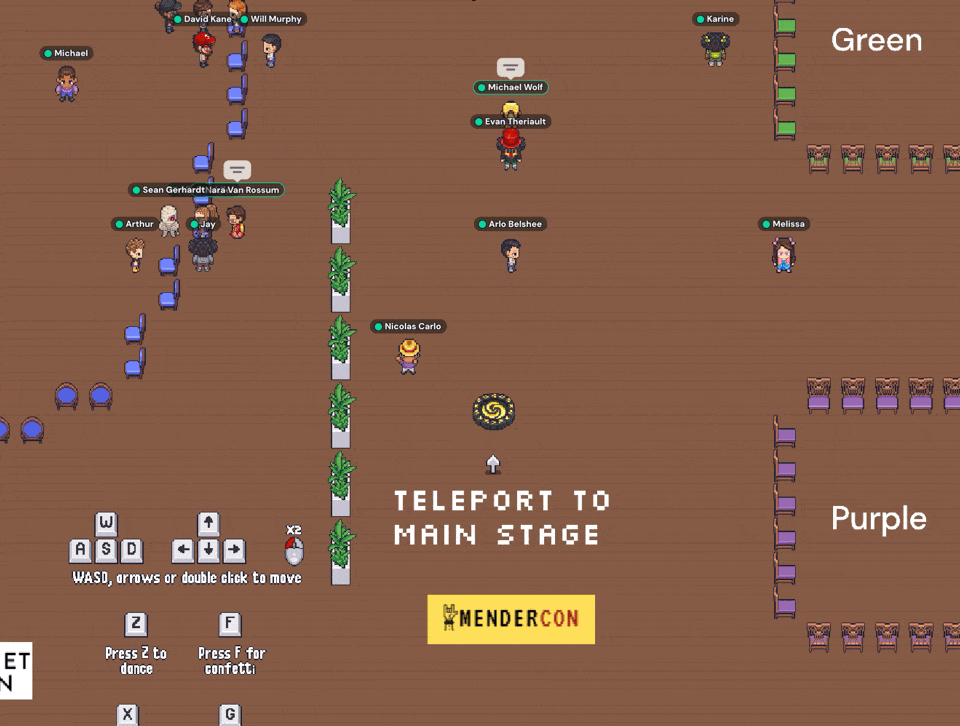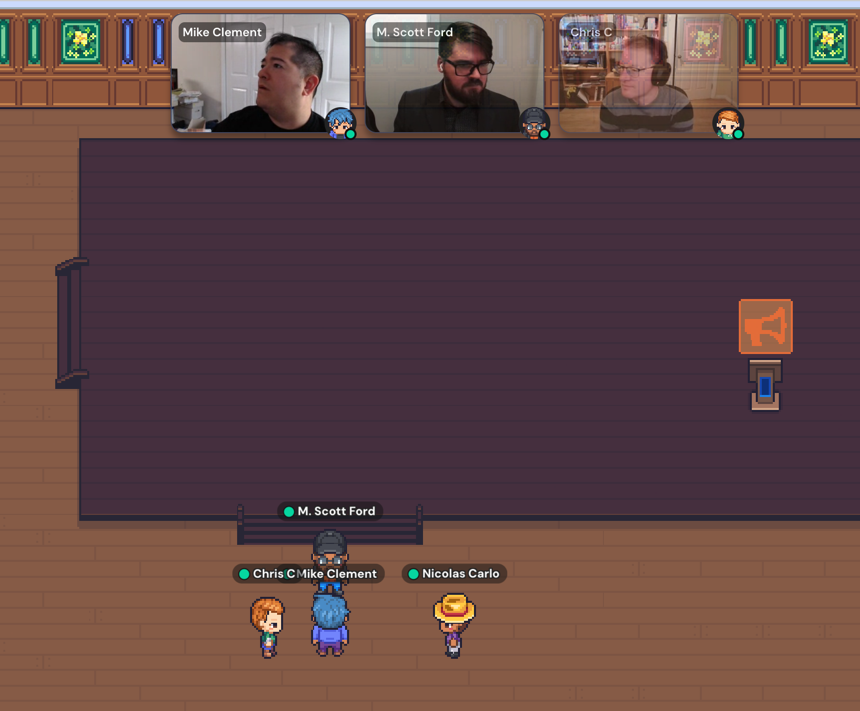Frequently Asked Questions
What platform is being used to host the event? Why?
This year we’re hosting the event on the Gather platform with main stage talks distributed using StreamYard.

The Gather platform allows event attendees to move around a virtual, game-like environment. It is like an old 8-bit video game that you play in your web browser. You can move your avatar around the virtual space.
As you get closer to other avatars, you can share you’ll see their video and hear their audio and they’ll be able to see and hear you.

Gather has a few useful guides to help you get started. Take a peek. Get used to the environment. Customize your avatar. Make sure your web browser and camera are set up correctly.
Our experience was that Gather helps with networking as attendees can “walk” around the space and organically strike up conversations with others.
The main stage content is visible via a live stream on YouTube, which can be watched from Gather or via our YouTube channel.
Why is the conference called MenderCon?
The term “mender” was coined by the founders of Corgibytes, M. Scott Ford and Andrea Goulet, after Scott saw an ad for a Maker Fest event and he thought, “Where’s the event for people who like to fix things?!” That’s exactly what MenderCon will ideally be - an event for people who are passionate about mending software systems.
What makes this different than every other virtual conference I've been to?
At MenderCon, we celebrate what makes us different from other software developers. Our event is different because we celebrate fixing bugs, rejoice in testing, and get giddy about legacy code. You’ll find a standard event track that has pre-selected speakers as well as an unconference track where you create the sessions. If you don’t see something on the schedule that you would like to take part in, you can create the space yourself and invite others to join you during the pitch session.
What's the unconference track about?
Simply put, an unconference is a conference that does not have a predetermined set of speakers or talks. The people who show up to the event are the ones who decide what gets talked about.
The unconference format also creates an opportunity to elevate voices who are not normally heard from. At a traditional conference, the list of speakers and topics is curated in some form by the organizers. This can often lead to the conference schedule being dominated by people who are well known or people who have gotten practice speaking in the past. While we welcome people with speaking experience and notoriety, it’s important to us that we create a space to where those who are not normally selected have a chance to speak. This is why we have a standard event track as well as an unconference track.
Why an unconference?
In addition to creating the opportunity to see some good talks, we wanted to create a space for other kinds of sessions, particularly ones that require some level of participation or discussion. With so many people working from home because of COVID-19, there are many who are craving more human interaction. We want to have MenderCon be a space for that. So don’t be surprised to see someone pitch a session that is simply titled something like, “Let’s chat about the unique challenges of refactoring PHP”, and when you get in the room there are no slides, just someone who wants to facilitate a conversation.
What do I need to prepare to pitch a session?
This depends on the kind of session that you want to run. On the simplest end, you can just prepare a topic or idea that you’d like to explore. That would be perfect for a purely discussion format. On the more complicated end, you can craft a slide deck and presentation or walk through a live coding demo. Those might work well if you plan on doing most or all of the talking during the session. We predict that many sessions are going to mix some elements of each of these approaches.
But, you have a standard event track as well?
Yes! We sent out a feedback survey after the first MenderCon event and a lot of folks expressed that they would like to see pre-selected speakers as well at the next event. We want MenderCon to be the event for menders, so we decided to add a second track that includes pre-selected speakers. If a participant doesn’t want to join in on the standard track, they can head over to the unconference track and join in on an a community session.
Will the sessions be recorded?
All sessions on the main stage will be recorded, and the recorded videos will be posted to the MenderCon YouTube channel after we’ve had a chance to edit them. You can expect the videos to be available within a month or two after the event is over.
None of the open space content is recorded. From feedback we’ve collected in previous years, when open space sessions are being recorded, some participants feel like they can’t be candid. That’s fair. We want to create a space where people feel they can show up and be themselves.
What do I do if I'm not sure which session to attend?
During each of the session rounds, there are going to be several different sessions going on at once, and it may be difficult to decide which session is the best one for you. The Open Space community employs the “Rule of Two Feet” to specify that you can leave a session at any time and join a session at any time. If you feel you’re in the wrong session, then switch to a different one. Don’t feel obligated to stay in a session for the full time just because you were there when it started. And similarly, don’t be afraid to join a session after it’s started.
And if an open space isn’t the kind of event that you get excited about, then you can check out the great content on the main stage or just “walk” around the Gather environment and meet some new people.
How can I help?
We’ve had a lot of people reach out and ask how they can help. Please reach out to us at info@mendercon.com if you’re interested in helping.